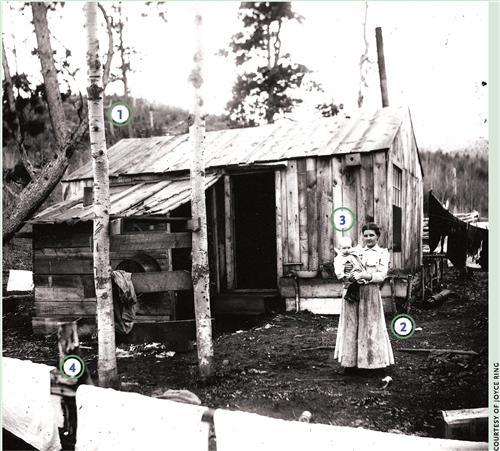Sign up for the Family Tree Newsletter Plus, you’ll receive our 10 Essential Genealogy Research Forms PDF as a special thank you!
Get Your Free Genealogy Forms
"*" indicates required fields

Seeing Is Believing
1 Back to nature. identify and research the habitats of trees and plants in the image.
2 Dress dilemmas. Conflicting fashion elements may indicate the wearer updated an older outfit.
3 Facing facts. Use genealogy data to identify candidates for an unknown subject, then compare her facial features to identified pictures.
4 Women’s work. In a casual shot such as this one, items around your subject reveal her daily activities.
Refuse litters the yard near pockets of snow. The home’s vertical plank walls look like weak protection from winter windows. But even though the family appears poor, their house has glass windows.
Joyce Ring owns this pioneer photograph, but doesn’t know the woman’s name. She sees a resemblance to her grandmother Helen “Nellie” Clarissa Burns Delimont, who was born in 1887 and lived her whole life around Almena, Kan. A cousin’s copy of this picture has the caption, “Grandma Nellie Delimont had an uncle killed in a mining accident-picture probably taken in Washington state.” But another copy is labeled, “Alice Gray and Louis Delimont taken in Washington state.”
Louis Delimont was Nellie’s son, and Gray, born in 1886, was her cousin. Which caption is right? We’ll use the rich detail in this photo to help tease out the truth.
Tree time
You never know when a photo caption may be inaccurate, so first up was researching the stated location. Behind the house, a modest hill hints this isn’t Nellie Delimont’s hometown in Kansas or the surrounding area. Research in my library’s topographical maps and at Google Images <images.google.com> (searching on almena kansas topographical map) confirms Almena doesn’t have any hills of this size.
The trees in this rural scene offer more clues. Pines dominate in the background, and the front yard features the white bark of aspen or birch. Sparse leaves suggest it’s late fall or early spring. Using Google Images again, I searched for aspen forest and birch forest to framed photos of trees and maps of their growing areas. Consistent with the captions, Wildlife Habitats <www.nwhi.org/index/habdescriptions> says aspens grow in Oregon and Washington. But we can add the Upper Midwest to possible locations: According to a Forest Service map <www.ncrs.fs.fed.us/fmg/nfmg/img/presettlement.jpg> forests of mixed aspen, birch and pine occur in northern areas such as Minnesota, Michigan and Wisconsin — worth noting because one of Ring’s ancestors wrote about living in the “deep forest country of Wisconsin.”
Clothing quandary
Louis Delimont, the baby named in a cousin’s caption, was born in 1924, but the somewhat confusing clothing clues here don’t support a date that late. This woman’s dress has a ruffled, yoked bodice and full sleeves. At first glance, these details indicate a date around 1900, but the skirt length and collar shape suggest a later era. In the pre-WWI period, women wore long skirts, and some blouses in the Sears catalog featured trimmed bodices. In 1900, women’s outfits had high collars, but this blouse has a turned-down collar similar to those from the early 1910s. A homemade and later updated dress could account for the style discrepancies. But it’s unlikely a woman would be wearing this dress as late as 1924.
Double takes
Ring owns several other photos she knows show Nellie Delimont as a girl and young woman. The woman here, who appears to be in her late teens or early 20s, has a similar-shaped face, lips and nose to known pictures of Delimont, suggesting she’s the one depicted. Add her birth date and age in this photo to the clothing clues, and we can date this photo to around 1910. The mysteries keep accumulating: If Delimont is the woman in this picture, why is she outside Kansas, and who’s the baby?
We can’t remove Alice Gray from consideration, though, since cousins often look alike and one of the captioned photos names her, To positively identify the woman and baby in this picture, Ring should learn more about Gray and track down pictures of her far comparison to this one, Gray lived with her parents in Oregon, and her father died in a mining accident there in 1891. This woman could be Gray in Oregon (not Washington) with her own child, rather than Nellie’s son.
Candid camera
Another obvious question about this intimate family scene is the identity of the photographer A, woman wouldn’t have posed for a formal picture in a ditty apron surrounded by drying laundry. Traveling photographers moved throughout the country taking photos of families they met along the way; one may have snapped this casual picture. It’s chilly enough outside for a coat, but Mom went without one and perhaps tidied her hair far the shot.
Ring’s photo mystery could be a case of well-intentioned relatives providing hit-or-miss information in their handwritten notations — underscoring the need for research to support what captions say With a little more work, this woman’s identity is a solvable problem.
From the March 2008 issue of Family Tree Magazine.
ADVERTISEMENT




